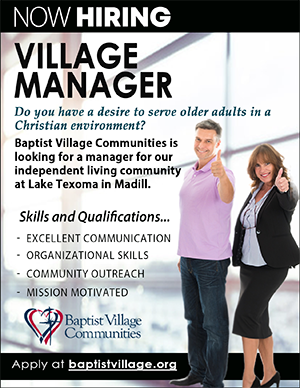“No Man’s Land”—for many people it is a vast expanse that is a long way from shopping malls and even Walmart. You can drive 40-50 miles to find a gas station or grocery store. Schools are small and if they have football, it may well be an eight-man team. “Downstaters” call it the Panhandle, but those who live there call it home.
The people who settled this land were of strong character and faith—they had to be. The pioneers who came here built ranches and farms. Enduring the harsh reality of cold winters, hot summers and drought was no small feat. Many families came to this part of Oklahoma hoping to build a great farming or ranching operation and simply had to leave their hopes behind, for only the hardy survived. Many of today’s landowners are the descendants of those who stared disaster in the face through the Dust Bowl days and refused to be defeated.
The Panhandle has some of the same physical challenges today as in the past; however, irrigation, hog farms, packing plants and “black gold” have made an appearance. The gas and oil industry is exploding, and population is exploding as well, as people come to work in the oil fields and on hog farms.
The true strength of the people of the Panhandle has always been their deep faith in God. As you drive through the small towns, church steeples are everywhere. Even during the years of declining population, the people kept their faith and kept their churches alive. Baptists have historically been strong in the Panhandle, and the churches are some of the most faithful in supporting our work in Oklahoma and to the ends of the Earth through the Cooperative Program.
One of our great ministries is the Baptist Collegiate Ministry (BCM) at Panhandle State University. For many years, this evangelistic and mission-minded ministry has been one of the most dynamic BCM ministries in the state and has produced leaders for Panhandle churches. The BCM is a respected part of the university family and has penetrated the student body with the Gospel.
The population growth in the Panhandle has brought great challenges for the churches. No place in Oklahoma has seen a greater growth in the Hispanic population than the Panhandle. It is so rewarding to see the association and churches planting Hispanic ministries. I applaud their determined effort to ensure that every Hispanic in that part of our state has a Gospel witness.
The churches of this area face the same issues as churches in other parts of Oklahoma. How can the faithful be served while discovering new ways to reach the younger generation? Will the older generations, who have stayed the course through good times and bad, recalibrate their focus from “us” to “them”? Will churches concentrate on the 99 in the sheepfold, or will they do what it takes to reach the one lost sheep? This question is really the challenge for all BGCO churches in Oklahoma.
I am confident the great men and women of the Panhandle will find an approach and will adapt to reach a new population and new generation. A way has always been found to not just survive, but thrive. I hope the rest of us take seriously the responsibility to focus on the lost sheep and not just those who are sleeping in the safety of the fold. The fate of the lost sheep depends on all of us. Frankly, the destiny of BGCO churches depends on whether the focus is truly on those who are lost.





